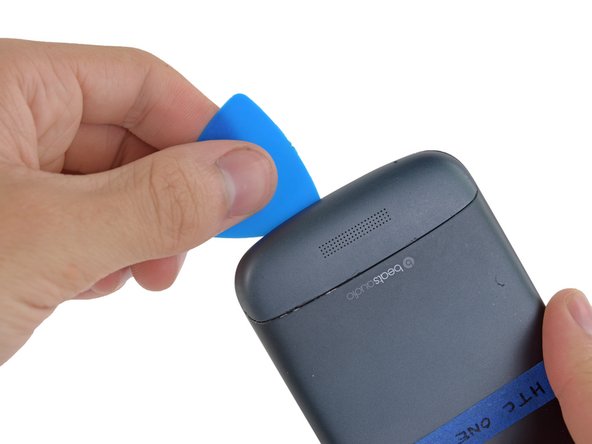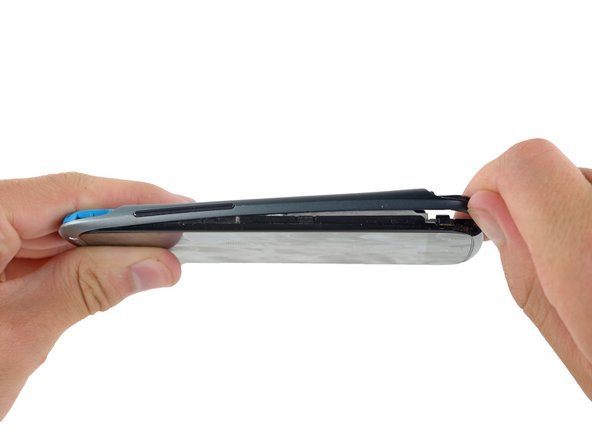Esta versão pode conter edições incorretas. Mude para o último instantâneo verificado.
O que você precisa
-
-
Encha uma panela ou frigideira com água suficiente para submergir completamente um iOpener.
-
Aqueça a água até ferver. Desligue o fogo.
-
Coloque um iOpener na água quente por 2 a 3 minutos. Certifique-se de que o iOpener esteja totalmente submerso na água.
-
Use um pegador para retirar o iOpener aquecido da água quente.
-
Seque bem o iOpener com uma toalha.
-
Sua bolsa térmica iOpener está pronta para o uso! Se precisar reaquecer o iOpener, aqueça a água até ferver, desligue o fogo e coloque o iOpener na água por 2 a 3 minutos.
-
-
Este passo não foi traduzido. Ajude a traduzi-lo
-
Handling it by the tag, place the heated iOpener across the bottom casing.
-
-
Este passo não foi traduzido. Ajude a traduzi-lo
-
Gently place an opening pick in the corner of the gap between the bottom casing and rear case.
-
Slide the opening pick along the side of the casing, prying it away from the adhesive as you go.
-
-
Este passo não foi traduzido. Ajude a traduzi-lo
-
Use your fingers to pull the bottom casing off the rest of the phone.
-
-
Este passo não foi traduzido. Ajude a traduzi-lo
-
Starting at the groove near the headphone jack, use a plastic opening tool to lift the top casing.
-
-
Este passo não foi traduzido. Ajude a traduzi-lo
-
Use your fingers to pull the top casing off of the rest of the phone.
-
-
Este passo não foi traduzido. Ajude a traduzi-lo
-
Remove the following screws holding the rear case to the rest of the phone:
-
Two 3.15 mm Phillips #00 screws
-
One 4.15 Torx T5 screw
-
One 4 mm Torx T5 screw
-
-
-
Este passo não foi traduzido. Ajude a traduzi-lo
-
Place your fingers on either side of the phone and gently push up on the rear case.
-
-
Este passo não foi traduzido. Ajude a traduzi-lo
-
Pull the rear case away from the rest of the phone with your hands.
-
-
Este passo não foi traduzido. Ajude a traduzi-lo
-
Using the pointed end of a spudger, lift the battery cable and release the connector.
-
-
Este passo não foi traduzido. Ajude a traduzi-lo
-
Switching to the flat end of the spudger, work your way underneath the battery and peel it away from the adhesive.
-
-
Este passo não foi traduzido. Ajude a traduzi-lo
-
Remove the three 3.15mm Phillips #00 screws from the turquoise case.
-
-
Este passo não foi traduzido. Ajude a traduzi-lo
-
Using a plastic opening tool, lift the turquoise case from the end near the headphone jack.
-
-
Este passo não foi traduzido. Ajude a traduzi-lo
-
A camera filter is now free to move, so remove it using tweezers.
-
-
Este passo não foi traduzido. Ajude a traduzi-lo
-
Use tweezers to lift the yellow polyimide tape that covers the ZIF connectors.
-
-
Este passo não foi traduzido. Ajude a traduzi-lo
-
Use the pointed end of a spudger to lift the white tab on the largest ZIF connector opposite the USB connector.
-
-
Este passo não foi traduzido. Ajude a traduzi-lo
-
Use the pointed edge of a spudger to work the ZIF cable out of its connector.
-
-
Este passo não foi traduzido. Ajude a traduzi-lo
-
Repeat the procedure from steps 19 and 20 to remove the cables from the remaining ZIF connectors.
-
-
Este passo não foi traduzido. Ajude a traduzi-lo
-
Using the pointed end of the spudger, pop the antenna cable from its connector on the motherboard.
-
-
Este passo não foi traduzido. Ajude a traduzi-lo
-
Remove the 3.15 mm Phillips #00 screw from the motherboard.
-













































